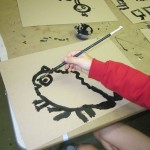
Categories
- Curriculum: Art, Language Arts
- Age/Grade: Elementary 1, Elementary 2, Elementary 3
- Subject: Analysis and Theory, Drawing, Painting
- Materials: Paint, Pencils
- Institution: Queens Museum of Art
- Location: Queens New York
- Duration: 1 - 2 Classes
Description
Students will learn that a drawing is a visual symbol that conveys a clear message or idea.
Objective
1. Students will enhance their understanding of the term symbol.
2. Students will explore the purpose and function of symbols in society.
3. Students will examine how the ‘readability’ of a symbol is necessary in order for it to serve as its intended function.
4. Students will become acquainted with the work of Keith Haring.
5. Students will enhance their understanding of how drawings can depict specific ideas or narratives.
6. Students will develop their ability to speak about works of art in a thoughtful manner.
7. Students will create drawings based on sculptures depicting their favorite animals that they observed on a zoo visit.
8. Students will develop their ability to depict ideas visually.
9. Students will enhance their ability to draw in a bold and simplified manner.
10. Students will exercise their critical thinking ability.
11. Students will exercise the use of their imagination.
Resources
Materials
18 x 24 Bristol Board, Pencil, Eraser, Acrylic Paint, Brushes (Thick/Thin), Water Containers, Paper Towels, Smocks
Procedure
Motivation: Engage group in a thoughtful conversation about the term symbol. What is a symbol? What function do symbols serve in society? Ask for examples and ask for volunteers to draw each one correspondingly. What is necessary in order for a symbol to effectively function as it was intended? Introduce images by Keith Haring and invite students to respond to them. What’s the similarity between these drawings and the symbols we looked at? What are the different images saying? What kinds of messages do they convey? Are they easy to understand? Is it important for the drawings to look realistic in order for them to convey a clear and specific message?
Exploring/Responding: Students will work directly from sculptures they made depicting a favorite animal they observed on a pervious zoo visit. They will sketch out their drawing in pencil first working to draw the animal large enough to encompass a large area of 18x24 surface. Once they’ve sketched the animal, they will imagine a suitable environment for their character to inhabit and sketch these details in the remaining background. Next, students will work with black paint solidify their drawing with a solid outline. When the paint is dry they will come back and add color. Encourage students to mix their own original colors rather than working directly from the colors in the bottle.
Closure: Examine everyone’s finished pieces together and discuss. Which of the artworks grabs your attention? What are some of the different stories that you see? Who are the different characters represented? How does the way that these characters are represented tell us about who the character is and what they are like? Are some pictures easier to understand than others? Is there an image that you really enjoy looking at even though you might not clearly understand what it is about?
Questions
Is there a way to teach students how to convey something visually in a condensed manner?
Extensions
Create a thumbnail story board for a comic strip depicting a day in the life of their animal character.
Pingback: Emoji: Modern Symbol Communication | OH THE ART PLACES WE CAN GO